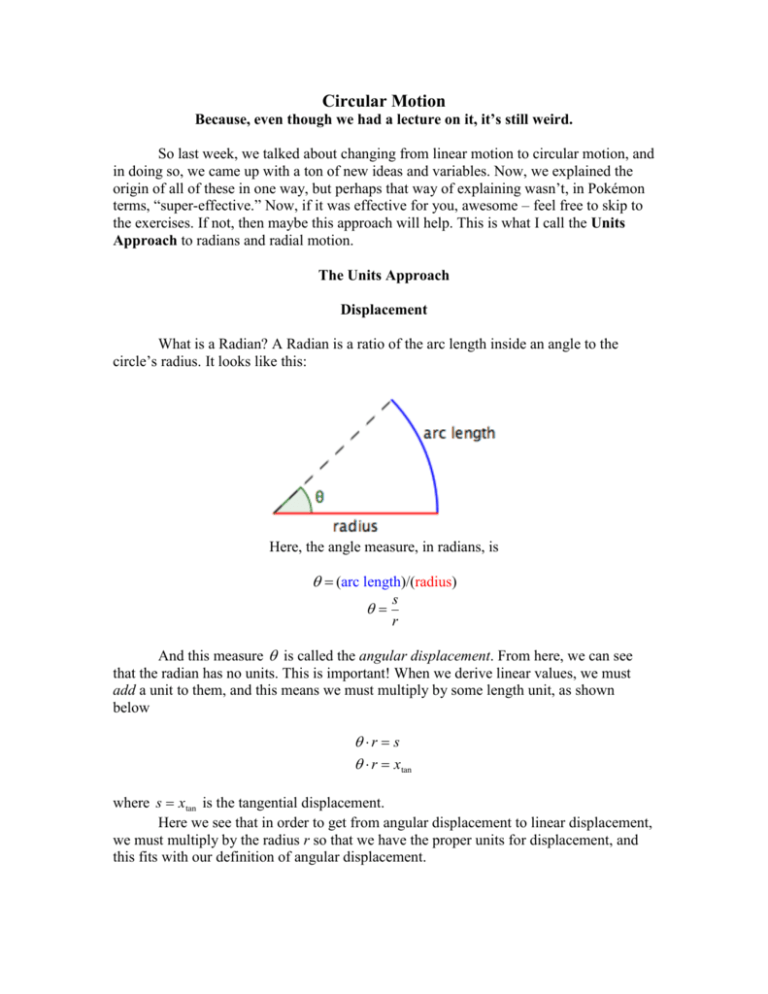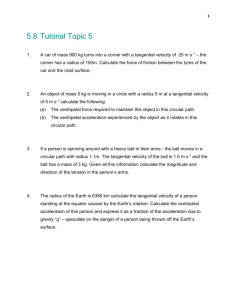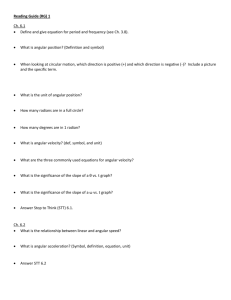File
advertisement

Circular Motion Because, even though we had a lecture on it, it’s still weird. So last week, we talked about changing from linear motion to circular motion, and in doing so, we came up with a ton of new ideas and variables. Now, we explained the origin of all of these in one way, but perhaps that way of explaining wasn’t, in Pokémon terms, “super-effective.” Now, if it was effective for you, awesome – feel free to skip to the exercises. If not, then maybe this approach will help. This is what I call the Units Approach to radians and radial motion. The Units Approach Displacement What is a Radian? A Radian is a ratio of the arc length inside an angle to the circle’s radius. It looks like this: Here, the angle measure, in radians, is (arc length)/(radius) s r And this measure is called the angular displacement. From here, we can see that the radian has no units. This is important! When we derive linear values, we must add a unit to them, and this means we must multiply by some length unit, as shown below r s r xtan where s xtan is the tangential displacement. Here we see that in order to get from angular displacement to linear displacement, we must multiply by the radius r so that we have the proper units for displacement, and this fits with our definition of angular displacement. Velocity It makes sense that, if the angular displacement is analogous to linear displacement x, and linear velocity v is defined by v x , t then angular velocity (called ) should be defined by , t and the units for angular velocity are radians per second. Hang on a minute! You said radians had no units. You’re right – they don’t. So how in the world could we get from angular velocity to linear velocity? The answer’s pretty simple here: we have a measure in radians per second (essentially in the units 1 s ) and we need to get to m s . We must, again, multiply by a unit of length. Like we did before, let’s multiply by r. This will give us meters per second, the unit we need to have linear velocity. v r Acceleration In a similar manner, since we know that linear acceleration a is defined by a v , t and so it should make sense, at this point, that the angular acceleration would be defined by t and is measured in radians per second per second, or rad s 2 . But radians have no units, so in order to get from angular acceleration to linear acceleration, we have to multiply by a unit of length. We use r again, and this gives atan v r r r( ) , t t t and this makes sense, because acceleration a is in m s 2 . We know of another kind of acceleration, though, and that’s centripetal acceleration, that keeps objects moving in circles. Now let’s use a definition we already have to figure out a good transformation for ac in angular terms. We know that centripetal acceleration ac is defined by ac v2 , r and the units here are meters per second per second, or m s 2 , and these units make sense from the calculation, as shown below ac . v 2 (m s)2 m 2 s 2 m 2. r m m s Now, we will use a transformation above to find ac in terms of angular velocity v r ac ac ac ac v2 r (r )2 r 2 2 r r r 2 and now let us check the units here, using what we know from above. ac r 2 m (1 s)2 m s2 And here we can see that the units of acceleration are still m s 2 . Now, it is important to note that ac is not the same thing as atan , because centripetal acceleration is always toward the center of the circular path, whereas angular acceleration is around the circular path. Exercises Let’s look at some examples to better acquaint us to these ideas. 1. Calculate the angular velocities of the second, minute, and hour hands of a clock in radians per second. 2. Calculate the tangential velocity of the arrows on each hand, given that the length of the second hand is 12cm, the minute hand is 15cm, and the hour hand is 10cm. 3. A unicyclist is traveling at a speed of 6 m s . What is the angular velocity of his feet, given that his wheel has a radius of 0.5m and his petals have a radius of 0.3m? 4. Ricky swings a yoyo in a loop of radius 0.42m with an angular velocity of 12.56 rad/s. What is the tangential velocity of the yoyo? What is its centripetal acceleration? 5. If Ricky changes the radius of his loop to 0.84m and its angular velocity to 6.28 rad/s over the course of 0.5 seconds, what is the new tangential velocity of the yoyo? What is the new centripetal acceleration? 6. What is the angular acceleration of the yoyo between 4. and 5. What is the tangential acceleration? You’ve reached the end! Woo Hoo! Now for some quick assessments for both you and me. PIECE OF CAKE. What parts of this worksheet were the easiest to understand for you? Why do you think that is? ________________________________________________________________________ ________________________________________________________________________ ________________________________________________________________________ ________________________________________________________________________ ________________________________________________________________________ STUDY UP Which parts of this worksheet were the most challenging to you? Why do you think that is? ________________________________________________________________________ ________________________________________________________________________ ________________________________________________________________________ ________________________________________________________________________ ________________________________________________________________________ HOW AM I DOING? This is the part of the assessment where you guys let me know what things I’m doing well, what things I could do better, and what kinds of things you would like to see more of. KEEP What am I doing well as your SLA Facilitator? ________________________________________________________________________ ________________________________________________________________________ ________________________________________________________________________ CHANGE What things could I do better? ________________________________________________________________________ ________________________________________________________________________ ________________________________________________________________________ HELP ME OUT What are some ideas for practice that would help you learn the material better, or make you feel more comfortable with it? ________________________________________________________________________ ________________________________________________________________________ ________________________________________________________________________ ________________________________________________________________________ ________________________________________________________________________







